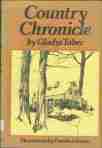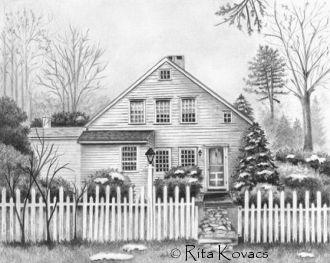I discovered Gladys Taber’s The Stillmeadow Road, a charming book about country life, at my mother’s house. It seemed I had given it to her for Christmas one year, and like so many presents we give others, it was the perfect gift for me. I read it during a blizzard, while my mother was in the hospital, and soon I was deep in Taber’s beautiful Connecticut winter of birds, beauty, cooking, shoveling, and frozen pipes. It gave me courage to face the next day, wading through thigh-high snowdrifts to get to the hospital.
Taber, who graduated from Wellesley and earned a master’s at Lawrence College, wrote cookbooks, the Stillmeadow series, and fiction. She was also the author of the “Diary of Domesticity” column for the Ladies’ Home Journal and the “Butternut Wisdom” column for Family Circle.
Taber and her husband bought Stillmeadow, a 1690 Connecticut farmhouse, as a vacation home with another couple in 1943. Taber and her friend Jill had been roommates in college, and desperately wanted a country getaway.
 In Country Chronicle, published in 1974, she retells the story of buying Stillmeadow. Taber writes:
In Country Chronicle, published in 1974, she retells the story of buying Stillmeadow. Taber writes:
“Eventually both families came to the city and faced the smog and noise and confusion and the problems of raising three children in gloomy apartments. Jill’s son, David, was four, her daughter, Barbara, six, and my daughter, Connie, eight. And one day as we walked the children along Central Park West, I looked up at the hazy sky and said, ‘If only we could get to the country for a weekend, a real weekend!’
‘Even a small piece of land we could put tents on,’ said Jill.
There was so much wrong with the house that they did camp in it at first. Gradually, they fixed the leaking pipes and replaced primitive appliances. After their husbands died, Gladys and Jill moved from New York City to Stillmeadow permanently.
Country Chronicle is one of her more charming books. Her reminiscences of family, neighbors, and pets are endearing. I love her tales of cats and dogs: Amber, the tiny cat with intestinal problems, grew up to be a gourmet who liked asparagus tips and fried shrimp; Silver Moon, a dog, needed a glass of tomato juice every day; and Sister liked beef stew, but disliked carrots, and picked the carrot out and arranged them around the plate.
Taber also writes thoughtfully about the environment, electric clocks, and our “push-button culture”: “When power fails, as it sometimes does even in summer, we do not know how to manage.”
One of the most surprising features of the book is her musing on the lack of privacy in the U.S. One spring she was chosen “to be investigated by the Census Bureau.”
“It’s strictly confidential, I was assured, for the census bureau is airtight against snoopers.”
“…But suddenly I began to wonder, and I did not want to fill all those pages about my way of living. We live in a climate of fear nowadays, second only to Communist countries. Newsmen go to jail rather than divulge the source of their special information. Houses are wired, telephones tapped, and the FBI has millions of names, innocent or not. The Watergate incident came to my mind as Mrs. S. took out her pen.”
The census woman asked Gladys idiotic questions about when she last bought sheets, how old her toaster was, and how much she spent on food. (She had no idea.) She wanted Gladys to keep notes on how much she spent for the next three months. Gladys “began to wonder how much 17,000 of these elegant portfolios, complete with pad and pencil and glossy pockets, must cost our rich government and how much the investigation cost and how far the money would go for food in poverty areas.”
Today our world is much less “snoopproof” than Gladys Taber’s in the ’70s. The Internet provides marketers with information gratis (and sometimes government agencies, though I know the internet corporations protect people to an extent). There are shopping records, and then there are our beloved e-mails, blogs, Twitter, and Facebook. Even if we are writing for ourselves, we all have the experience at least once of being read by someone who dislikes us. A divorce lawyer, or an employer can take things on Facebook out of context. (I’m always reading iabout people who have lost their jobs because of what they said on Facebook.)
Even our e-readers track information about how fast we read, how long we read, and what we highlight. And, lord knows, I love my e-reader.
Our computers are our friends: we keep in touch with family and friends, organize political meetings, or read newspapers. We write. We make friends.
But it is disconcerting to think that all of it can be used for surveillance.


I enjoyed reading this and liked the pictures — especially the one on your LeGuin blog. I’m interested in the idea that the 1970s census was a form of surveillance. Today I was reading an article on how coporations and the govt’ today sent spies to activitist groups, including those pro-animal. Julian Lesange was a great threat to these people.
It’s Katrina Forrester on the LRB on Secret Manoeuvres in the Dark: Corporate and Police Spying on Activists by Eveline Lubbers.
http://www.lrb.co.uk/v35/n01/katrina-forrester/i-want-you-to-know-i-know-who-you-are
Ellen
LikeLike
Yes, I would never have thought of the Census as intrusive, but the questions she asked Taber on her visit (the first of three) and then the book-length questionnaires Taber had to fill out made her wonder why the government needed to know these thing. We think less about privacy now perhaps because it’s lost? I just read something about drones being used for surveillance in the U.S.
The other books by Taber have been solely about her love of Stillmeadow, but this book, published shortly after Watergate, raises some disturbing questions about the government, too.
LikeLike
I thought I had read another of Taber’s books in addition to ‘Mrs. Daffodil’ but apparently not. My library has a copy of ‘Still Cove Journal’ (I think this is about Cape Cod) and ‘Stillmeadow Calendar’ so I will seek them out.
LikeLike
How lucky that your library has them! Yes, there’s Stillmeadow and Cape Cod. I like reading her column/essays. She doesn’t get overly sentimental, like some of the women’s columnists I have read.
LikeLike
Have loved the Stillmeadow books for years and it was a precious connection for my mother and me.
LikeLike
I love her books, too, and the Stillmeadow books always cheer me up. Since it’s November, I should take one off the shelf. Cheers!
LikeLike